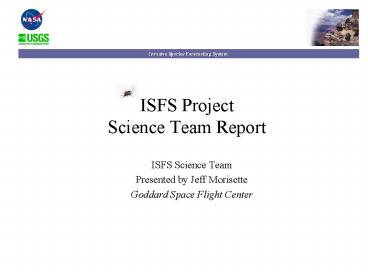ISFS Project Science Team Report - PowerPoint PPT Presentation
1 / 14
Title:
ISFS Project Science Team Report
Description:
IDS / Avian Bioenergetics Modeling. Large-Scale Assessments. 8/27/09 ... IDS2: Avian Bioenergetics Modeling (Smith) Performance & Schedule ... – PowerPoint PPT presentation
Number of Views:44
Avg rating:3.0/5.0
Title: ISFS Project Science Team Report
1
ISFS ProjectScience Team Report
- ISFS Science Team
- Presented by Jeff Morisette
- Goddard Space Flight Center
2
Outline
- Science Team Summary
- Science Plan Overview Discussion
- Advancing three science themes
- Organized by a series of Modeling tasks
- Research Reports
- EOS / Value-Added MODIS
- IDS / Biological Fingerprinting
- IDS / Avian Bioenergetics Modeling
- Large-Scale Assessments
3
Science Team Summary
- Partners Projects
- Partners USGS, CSU, USDA, Ag Forest Service,
NPS, Stennis Space Center, EO-1 and ASTER teams,
Tamarisk Coalition, Colorado DNR, Miss. State U,
UMaine, George Mason University - Projects
- Valued added EOS products (Morisette)
- IDS1 Biological Fingerprinting (Stohlgren)
- IDS2 Avian Bioenergetics Modeling (Smith)
Performance Schedule v Jan 04 IDL Software
training at GSFC v Mar 04 T-Map and NIISS-web
established v Mar 04 Software to ingest MODIS
VI time series v Mar 04 Software to summarize
MODIS VI time series v May 04 First Draft of
Science Plan v May 04 Value Added project
funding start Jun/Jul 04 IDS 1 project
funding start Aug 04 ESA presentation on the
need for time series analysis Aug 04 Manuscript
submitted on time series work 04/05 Tamarisk
modeling efforts 04/05 Cheatgrass/thistle
modeling efforts 04 Eastern US pilot
study 04/05 Eastern US/Aquatics
proposal/project 05/06 Interaction with LTER,
starting with Konza Prairie 05/06 Study impacts
of fire at Cerro Grande 05 on Use maps for
where invasive species are to start exploring how
they became established, and inferring where they
will go.
- Status Issues
- Currently exploring MODIS Vegetation index
- Additional MODIS products and meteorological data
are next to be considered - ISFS database will help manage growing archive
- Funding through the Value added project will
allow further exploration of stat. Models - Funding for Biological fingerprinting will
address key issues and expand area
4
Collaborators
USGS/CSU Stohlgren, lead collaborators Kalkhan,
Reich statiatical modeling Evangelista/Graham/Ne
wman/Crossier field data to ingest Agencies/NG
O USDA, ARS Hyperspectral airborne imagery over
Tamarisk, Curruthers, Delfouse USDA Forest
Service Colorado mapping pilot project,
Czaplewski Colorado DNR Colorado mapping pilot
project NPS Tamarisk Coalition Bill Cheatum,
Tamarisk modeling Universities Miss. State U
Bruce feature extraction, Madsen -
aquatics Umaine Eickhorst - spatio-temporal
helix modeling George Mason University
Gentle/Cai, - statistical analysis, Garnet
field spectra aquatics U.Alabama, Huntsville
Graves, expertise of Earth Science
data/metadata NASA Application Division
Scheffner and Turner Stennis Space Center,
McKellip applications program, Griffith
Tamarisk with ASTER EO-1 team at GSFC,
hyperspectral satellite imagery ASTER team
multi-temporal, multi-spectral imagery
5
Science Plan
careful observation of current patterns of the
invasion of nonnative plant species in natural
landscapes might provide a reasonable staring
point for the design of more realistic
experiments and mathematical models, and in the
search of a generalized theory of
invasion. Stohlgren, Beyond Theories of Plant
Invasions Lesson From Natural Landscapes,
Comments on Tehoretical Biology, 7 355-379, 2002.
6
Science Plan Major Themes
- The research plan is designed to advance three
major science themes - Application of new data sources, focusing on EOS
products, - Advancing biological modeling techniques for
species distributions, and - Increasing the geographical extent for biological
distribution modeling.
7
Science Plan Research Strategy
- The science plan has been organized into a series
of ten modeling tasks designed specifically to
achieve the projects overall goals. - These modeling tasks fall into six main
categories - Species richness
- Cheatgrass and Canadian Thistle
- Tamarisk
- Native vs Non-native grasses
- Woody Encroachment
- Aquatic Species
8
Science Plan Research Strategy
Main Category 1 - Species Richness
Theme A New Data
Theme B Better Models
Theme C Extent
Modeling Exercise 1.1 Total Plants at Three
Study Sites
Introduce MODIS data to ISFS
9
Science Plan Research Strategy
Main Category 2 - Cheatgrass and Canadian
Thistle
Modeling Exercise 2.1 RMNP 2.2 Colorado 2.3 W
estern US
EOS, met, and GIS layers
Model and variable selection
Field data from multiple sources NIISS web
system w/ ISDS
Validation and uncertainty information
From local to state level
Field data from inter-state, inter-agency sources
Predictions with sparse data
From local to near-national level
10
Science Plan Research Strategy
Main Category 3 - Tamarisk
Modeling Exercise 3.1 w/ Hyperion 3.2 w/
ASTER 3.3 in ISFS
Hyperspectral Satellite data
Hyperspectral classification
Multi-temporal ASTER data sensor web
multi-spectral, multi-temporal and
meteorologically based prediction of phenology
From small Hyperion or airborne footprint to
ASTER coverage
EOS, met, and GIS layers T-map data
Exploit the statistical modeling framework of the
ISFS
Extend to T-map coverage
11
Science Plan Research Strategy
Main Category 4 Native vs Non-Native grasses
Theme A New Data
Theme B Better Models
Theme C Extent
Modeling Exercise 4.1 Native/Non-native grass
distribution at Cerro Grande fire site
MODIS fire and burnt area products
Replicate modeling techniques from 2.1
Fire disturbance sites
12
Science Plan Research Strategy
Main Category 5 Woody Encroachment
Theme A New Data
Theme B Better Models
Theme C Extent
Modeling Exercise 5.1 Quantify Woody expansion
at Konza Prairie LTER
MODIS fire, land cover change and percent tree
cover
Replicate modeling techniques from 2.1
Outreach to LTER network
13
Science Plan Research Strategy
Main Category 6 Aquatics Species
Theme A New Data
Theme B Better Models
Theme C Extent
Modeling Exercise 6.1 Utilizing Hyperspectral
data to map Phragmites
Hyperspectral Satellite data
Application of modeling to aquatic species
East and Southeast US
14
Mapping Exercises by main categories with
interdependencies
CheatgrassThistle
Tamarisk
Native/Non-Nativegrass
WoodyEncroachment
Aquatics
SpeciesRichness
ESA presentation Manuscript
Contribute to Grand Challenge































